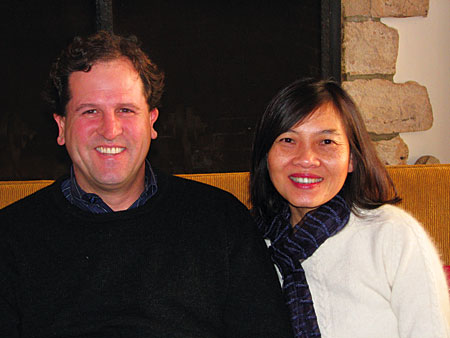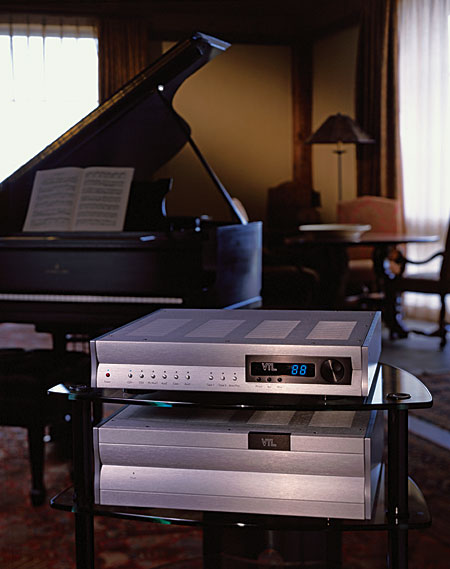| Columns Retired Columns & Blogs |
Lovely article!

Soon after the doors opened, I headed to the room of longtime Southern California dealer Brooks Berdan Ltd. Seated in the sweet spot, I was delighted to hear irresistibly delicious, remarkably controlled full-range sound. Such an experience is unusual on the first day of an audio show, when most exhibitors are still trying to figure out what sounds best where and how to tame impossible bass humps. But in Berdan's room, music didn't simply sound attractive and right, it sounded positively seductive.
The system consisted of a Jadis CD player used as a transport driving a Jadis D/A converter via Pierre Gabriel cable; a VPI Aries 3 turntable with a Benz LP cartridge; VTL's TL-7.5 Series 2 line-stage preamplifier, TP-6.5 phono preamplifier, and prototype MB-450 Signature autobias monoblocks; Wilson Audio Specialties Sophia Series 2 speakers; Cardas Golden Reference cables; and RPG room treatments. CDs and LPs both sounded wonderful.
In all my years of attending hi-fi shows, this was the first time that I had given a serious listen to VTL electronics, and I was definitely impressed. Once I'd made my preference for classical music known, VTL's Luke Manley introduced himself. "Here, let me play you this LP of tenor Fritz Wunderlich," he enthused. Only later did I learn that VTL uses Wunderlich's sterling voice to help evaluate the sounds of their products.
In the next half hour, during which I also listened to several of my own reference CDs, it became clear that this was one of the best-sounding setups I'd ever heard at a show. When Manley and I discovered that we both lived in the San Francisco Bay Area, he invited me to drive from Oakland down to Sunnyvale to listen to music some weekend, when he and his wife, Bea Lam, were not at work at the VTL factory in Chino, east of Los Angeles.
Not long thereafter, I made the first of many visits. United by a love of classical music as well as of jazz, we three have so far spent six afternoons together, taking turns auditioning equipment and enjoying music at each other's homes. Never one to shirk the live reference, Luke and I have also attended a recital by tenor Rolando Villazón in the gratifying acoustic of UC Berkeley's 770-seat Hertz Hall.
VTL's Evolution
Vacuum Tube Logic, aka VTL, has come a long way since Luke's father, David Manley, founded the company in the UK in the early 1980s. According to Luke, who as a teenager began slinging solder with his dad in their native South Africa in the late 1970s, David first began trying to make a realistic-sounding, reliable amplifier during his early days working as an engineer in a recording studio. After concluding that tubes were the best way to go, he began to design very simple circuits that were powerful and dynamic.

David and the company relocated to Rhode Island in 1986, and to Chino in 1987. VTL soon began to produce a series of classic, high-power amplifiers, the front panel of each of which boldly proclaimed "DESIGNED BY DAVID MANLEY." All VTL amps shared a "family sound" that to this day derives from a paralleled input stage, a long-tail phase-splitter driver, a push-pull output stage, a big solid-state power supply with huge capacitors, and a wide-bandwidth output transformer. This VTL formula of a very big solid-state power supply married to a simple, all-tube circuit produces what Luke calls VTL's characteristic dynamic, uncolored sound, with a rich midbass and an extended top end.
"We don't want a soft, euphonic retro-sound, or something that has exaggerations in the bass or the top end," he explained during one of our visits. "The more you complicate the circuit with additional components, the more you potentially add to or detract from the original signal."
In 1993, irreconcilable differences surfaced between David and Luke concerning VTL's future direction. David was designing and manufacturing both professional gear, which he sold under the Manley Labs moniker, and hi-fi gear, which carried the VTL logo. He was also in the midst of recording, live to two tracks, a number of rather eclectic albums in naturally reverberant acoustics, and issuing them on LP and CD on his ViTaL label. When David wanted to come out with a guitar amp, and switch the company's marketing strategy from mail-order sales through Audio Advisor to direct marketing, Luke said no way.
"We couldn't agree on how to run the business," Luke explains. "I didn't want to be involved with the pro stuff, because I didn't know anything about that end of the business. I didn't like the record label, because it was a totally different enterprise. We were just doing too many things. I wanted to take VTL in the direction I thought it needed to be taken, which involved completely changing the dealer profile. So we split the business right down the middle: the employees, the parts, everything. My father and his new wife, EveAnna, who had recently graduated [from] Columbia University as a music major, got their own building and took Manley and ViTaL with them (footnote 1), while I retained VTL."
Distribution Bull's-eye
Luke immediately set out to build a robust dealer network. Targeting solid-state amp dealers with a common profile—Mark Levinson, Wilson Audio, and Transparent Audio—he offered them a user-friendly tube line as an alternative.
"We would have been hitting our heads against a brick wall to have gone to Audio Research dealers," says Luke, "because Audio Research was too powerful at the time. It also wouldn't have made sense for dealers to switch from tubed Audio Research to tubed VTL. Instead, we went to solid-state Levinson dealers and presented them with a whole new customer prospect—a music lover who probably wasn't even coming into their store, was open to what a supposedly old technology could accomplish, and who sought an alternative to the sound of solid-state amps. I could see that the dealers wanted to attract music lovers, but they didn't want to bring in hands-on hobbyists who were going to be rolling tubes and asking all sorts of tubey questions that these dealers weren't equipped to answer."
Luke's strategy was successful and in turn defined VTL's target customer: someone who wants to be able to play great music without having to fiddle with things. It also pointed the way toward the kind of products and features VTL has since developed.
"When we split up in '93, there were things that needed to be done," Luke explains. "We had dynamic-sounding tube amps with solid-state power supplies and simple circuits. But we didn't even have a remote control. We needed to go to the next level.
"Nowadays you need to have all sorts of functionality: remote control, power supplies that are precision-regulated as in the [VTL] Siegfried [power amplifier], auto-bias technology, microprocessor control, software, and fault-sensing to identify malfunctioning tubes. Our new 7.5 preamp uses MOSFETs in the output stage but tubes in the gain stages. That involves solid-state technology, which was not my dad's forte. Our products have become more sophisticated, and require a wider skill set than that found in one person. That's why I manage five engineers. One guy does tube stuff, one does MOSFET and power supply, another does control circuits and software and different areas of board layout.
"It took us 10 years of costly research to develop effective auto-bias circuitry that does not detrimentally affect the sound. Auto-bias is a true controlled system, microprocessor in our case, that improves sound because the tubes are always at the right (optimal) operating point, instead of changing when the AC changes. Even in the case of the Siegfried, whose precision-regulated supplies keep electrical power constant regardless of what's on the line, tubes change as they heat up and cool down."
And Then There Were Two
Shortly after Luke took charge of VTL, Bea Lam entered the picture. Born in China and raised in Hong Kong, Bea fell in love with the piano when she was six or eight. When she was 10, a neighbor's older son let her hear and eventually borrow an Ampex open-reel tape deck, with which he had recorded classical music. Stunned by the sound of the classics, Bea began studying piano and buying classical recordings. By the time she was 18, shortly before she came to the US to study electrical engineering at Cornell, she knew much of the classical repertoire.